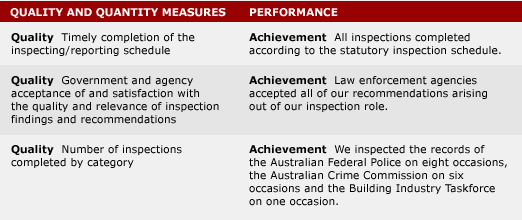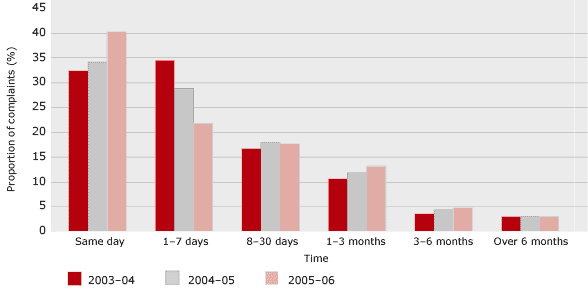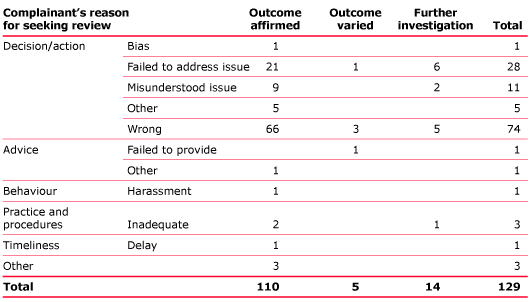Commonwealth Ombudsman Annual Report 2005-06 | Chapter 3 | Performance report


CHAPTER 3 | Performance report
Introduction
This chapter details the performance of the office based on the outcome and outputs structure set out in the Portfolio Budget Statements and Portfolio Additional Estimates Statements 2005–06.
The office of the Commonwealth Ombudsman has one outcome supported by two outputs:
Outcome: Administrative action by Australian government agencies is fair and accountable
Output 1: Review of administrative action
Output 2: Review of statutory compliance in specified areas.
Our original price of outputs of $12.495 million was increased at Portfolio Additional Estimates. An additional $5.592 million was allocated to allow our office to perform specific reviews relating to immigration detention decisions.
This chapter outlines our achievements against the outputs and broadly explains the ways in which we continue to work towards the outcome.
Performance at a glance
TABLE 3.1 Summary of outcome and outputs price
| Budgeted price of outputs | $18.087m |
| Actual price of outputs | $18.384m |
| Budgeted departmental appropriations | $17.035m |
| Actual departmental appropriations | $17.035m |
| Budgeted revenue from other sources | $1.052m |
| Actual revenue from other sources | $1.349m |
A financial overview is provided in Chapter 4—Management and accountability. Full details of the total price of agency outputs of the Ombudsman's office are provided in Note 16 of the Financial Statements in this report.
TABLE 3.2 Summary of outcome and outputs performance
OUTPUT 1 Review of administrative action

OUTPUT 2 Review of statutory compliance in specified areas

1.1—Inquiries, approaches and investigated complaints meet service standards
In the past two years, we have reviewed our internal complaint-handling processes and implemented a new complaints management system that adds rigour and increases national consistency in our work practices. Our new procedures include a five-tiered structure for categorising and responding to complaints, based on the type of approach, the degree of effort required to resolve a complaint, and any potential sensitivities. The procedures also require that approaches and complaints in particular categories be reviewed for quality assurance purposes.
This more structured approach will provide additional assurance to government and the public that we handle approaches and complaints efficiently and consistently, and that we have appropriate levels of quality assurance. The structure also delineates a clear review path for complainants dissatisfied with decisions made by our staff.
Timeliness
In 2005–06, we finalised 80% of all approaches and complaints within one month of receipt (in line with previous years), and finalised 54% of investigated approaches and complaints within one month (65% in 2004–05).
Data from our complaints management system is used to monitor response times by the office and to identify delays in complaint investigation. With many of the complaints we investigate we need to factor in the time that it takes an agency to provide us with information.
The Complaints (Australian Federal Police) Act 1981 establishes different complaint-handling procedures for complaints about the Australian Federal Police (AFP). The majority of investigations and conciliations of complaints are first conducted by AFP Professional Standards, followed with a review by our office. This is necessarily a longer process than for the handling of general complaints, with 87% of all complaints finalised within six months of receipt (83% last year). We expect to reduce the time taken to resolve complaints about the AFP as a result of the Law Enforcement (AFP Professional Standards and Related Measures) Act 2006, which is awaiting proclamation. See the 'Looking at the agencies—Law enforcement' section of Chapter 7 for further information.
The Ombudsman has reported in detail about timeliness in the handling of complaints about ACT Government agencies and community policing in a separate report as ACT Ombudsman. This report is available at www.ombudsman.act.gov.au.
Figure 3.1 shows the time taken to finalise approaches and complaints for the past three financial years.
Figure 3.1 Time taken to finalise all approaches and complaints, 2003–04 to 2005–06

Remedies
As in previous years, the most common remedy for complaints was the provision of a detailed explanation by an agency of its decision or action. This was particularly the case in complaints about police, and reflected the ongoing commitment of the AFP to conciliation of less serious matters.
A remedy was provided in 19% of complaint issues investigated and finalised (22% in 2004–05). A breakdown of remedies is provided in Appendix 4—Statistics.
1.2—Assessment of feedback received from the public
 In 2005–06, we implemented several initiatives to improve the quality and timeliness of the service we provide to both complainants and agencies. The
initiatives include:
In 2005–06, we implemented several initiatives to improve the quality and timeliness of the service we provide to both complainants and agencies. The
initiatives include:
- creating the Public Contact Team, to provide a responsive service to callers who need to be referred to an agency in the first instance, and to ensure that matters needing investigation are appropriately referred to an investigation officer
- putting in place new work practices, supported by a comprehensive work practice manual and the Professional Standards Team, to ensure that we continue to provide timely and effective service
- setting up a new complaints management system that enables us to identify complaint trends and workload shifts more quickly and to provide support for our new five-tiered complaint management structure.
We took many of these steps because of survey feedback from the public and unsolicited feedback from both agencies and individuals. Being responsive to public comment about our service, we created mechanisms to mandate and communicate best practice throughout our national office structure. The tiered structure for complaint management ensures that the office deals appropriately with any feedback about our service.
'... creating the Public Contact Team ... putting in place new work practices ... setting up a new complaints management system ...'
We apply the same principle to our own operations that we promote to other Australian Government agencies: specifically, if a person is not satisfied with the way in which an investigation has been handled they can follow a clear procedure to seek an internal review of the matter.
Our Client Service Charter sets out the internal review process we offer to complainants. A more senior officer who was not directly involved in handling the original complaint carries out each internal review.
We received 96 requests for internal review, a 26% decrease on the number of requests received in 2004–05. We finalised 129 reviews during the year, including 33 that had been carried over from 2004–05 (Table 3.3). The original outcome was affirmed in 110 finalised reviews (85%). The office agreed to conduct additional investigation in 14 reviews and agreed to change its decision on the original complaint in five reviews.
Table 3.3 Internal review of Ombudsman action, requests and decisions, 2005–06

Of the 129 reviews conducted, 92% related to decisions or actions of an officer in the course of complaint investigations. Complainants sought reviews mainly because they believed the decision we made or the advice we offered was wrong or that we failed to address or misunderstood the complaint issue.
1.3—Response to advice, submissions, services, findings and recommendations by government agencies and other organisations.
1.4—Agency satisfaction with the quality of services/acceptance of findings and recommendations.
This year, the Ombudsman released public reports on seven own motion and major investigations. The reports contained a total of 51 individual agency recommendations—agencies accepted 49 of the 51 recommendations.
- September 2005—Department of Immigration and Multicultural Affairs: inquiry into the circumstances of the Vivian Alvarez matter.
- October 2005—Australian Defence Force: management of service personnel under the age of 18 years. The ADF did not support the recommendation that it undertake an analysis of the costs and benefits of accepting minors for enlistment in the ADF with a view to determining whether the enlistment age should be raised to 18 years.
- February 2006—Department of Immigration and Multicultural Affairs: administration of s 501 of the Migration Act 1958 as it applies to long-term permanent residents. DIMA did not support one of the recommendations, as it was considered to be a matter for the Australian Government.
- March 2006—Administration of the Freedom of Information Act 1982 in Australian Government agencies.
- March 2006—Australian Taxation Office: administration of the superannuation co-contribution scheme.
- March 2006—Department of Immigration and Multicultural Affairs: report on referred immigration cases: Mr T.
- April 2006—Department of Immigration and Multicultural Affairs: management of a frail, aged visitor to Australia.
Two indications of a high degree of satisfaction with our capacity to conduct thorough, rigorous and fair investigations are that agencies accepted the overwhelming majority of the Ombudsman's recommendations and that several of these investigations were conducted at the request of the Australian Government or the relevant department.
Several current own motion investigations that will be completed in 2006–07 include investigations into:
- issues relating to the implementation of the marriage-like relationship policy
- the administration of the pension bonus scheme
- complaint-handling procedures available in airports
- the management of complaints about unacceptable behaviour in the ADF
- the complaint-handling process of the Migration Agents Registration Authority
- the quality of the notification of reasons by DIMA for decisions and review rights for refused visa applicants.
In June 2005, the Australian Parliament amended the Migration Act 1958 to confer on the Ombudsman a new role of reviewing the cases of people who had been in immigration detention for two years or more. At the end of June 2006, we had received 235 reports from DIMA concerning 262 people who had been in detention for two years or more. We had interviewed 167 people and provided reports on 70 cases. The minister had tabled responses to 66 of those reports in parliament.
Of the 106 recommendations contained in these 66 reports, the minister agreed to 51% of the recommendations, disagreed with 25% and delayed making a decision on a further 24%. Of the reports where the minister disagreed with the Ombudsman's recommendations, 46% concerned the grant of a bridging visa and 42% concerned the Ombudsman's recommendation that the minister make a decision before tabling the report in parliament. The remaining 12% involved consideration of an alternative to detention, the issue of a permanent visa or the revocation of a decision to cancel a visa.
See the 'Looking at the agencies—Immigration' section in Chapter 7 for further information on immigration-related matters.
1.5—Number and complexity of complaints/issues received and investigated and number of enquiries and approaches received.
Approaches and complaints received
In 2005–06, we received 28,227 approaches and complaints, 17,384 of which were within the Ombudsman's jurisdiction (17,310 in 2004–05).
Approaches to the office ranged from simple contacts that could be resolved quickly, through to more complex cases that required the formal use of the Ombudsman's statutory powers. The decision to investigate a matter more formally can be made for a number of reasons:
- need to gain access to agency records by a formal statutory notice
- complexity or seriousness of the issue under investigation
- nature of the allegations made by a complainant
- time taken by an agency to respond to our requests for information
- likely effect on other people of the issues raised by the complainant.
In addition to the 17,384 approaches about particular agencies within our jurisdiction, we also dealt with approaches about matters outside our jurisdiction or requests for information. We received 10,843 of these approaches (12,013 in 2004–05). While it is difficult to attribute this decrease to a specific reason, two possible factors are greater public awareness of the complaint mechanisms available within agencies, and increased public awareness of the role of the Ombudsman because of outreach activities undertaken by the office.
This year, 2,046 approaches and complaints were lodged electronically, an increase of 43% from 2004–05. We have helped people lodge complaints electronically by improving our online complaint form on our website. The new form provides information at each step of the process to help complainants to complete the form and to determine whether their complaint is within our jurisdiction.
There was a decrease of 15% in the number of approaches and complaints lodged in person and an increase of 3% in the number of written approaches. Table 3.4 details approaches by method received.
Table 3.4 Approaches and complaints, by method received, 2003–04 to 2005–06

In February 2006, we created the Public Contact Team to manage all initial approaches to the office. This team of 12 people provides a national contact point for all telephone approaches and responds to all electronically lodged complaints. The members of the team enter the details of the complaint on the complaints management system and assign the complaint to the most appropriate investigation officer. Where necessary, they explain the limits of the Ombudsman's jurisdiction and refer the person to a more appropriate agency. Between February 2006 and 30 June 2006, the team handled 24,235 telephone calls.
Approaches and complaints by agency
Of the 17,384 approaches and complaints received within the Ombudsman's jurisdiction, 12,990 (75%) were about Australia Post, the Australian Taxation Office, Centrelink, the Child Support Agency, and the Department of Immigration and Multicultural Affairs.
Charts comparing trends over the past five years for these agencies are included in Chapter 7—Looking at the agencies.
Approaches and complaints finalised and investigated
We finalised 16,507 approaches and complaints within our jurisdiction (17,441 in 2004–05).
Approaches and complaints made to the Ombudsman often include several issues. For example, a complainant may allege not only that a decision was substantively wrong, but also that the agency failed to provide accurate advice, was unreasonably slow, or that the staff of the agency displayed an inappropriate attitude. Similarly, different issues within the same complaint may result in different actions by the Ombudsman's office. In this example, the office may suggest that the complainant pursue internal review mechanisms with respect to the agency's substantive decision, but may investigate the issues around delay and service delivery. It is for this reason that we also report on complaint issues finalised by the office.
In 2005–06, 17,508 issues were finalised. Of the issues finalised, we investigated 35% (33% in 2004–05). The remaining complaint issues were usually finalised by referring the complainant to the internal complaint processes of the agency, or deciding that investigation of the issue was not warranted.
Of the issues investigated and finalised, some agency error or deficiency was identified in 1% of complaints (14% last year). No error or deficiency was identified in 11% of instances (43% last year). In the remaining 88% of issues investigated, we resolved complaints without the need to determine whether the cause of the problem related to administrative deficiency, and made no determination about the agency's performance.
This reflects our office's new emphasis on working to resolve a complaint efficiently by identifying a practical solution or remedy that assists the complainant. Often we can do this without determining that an agency acted correctly or that there was an administrative deficiency in its conduct. The new approach also acknowledges that most complaints are resolved through the cooperation and responsiveness of agencies, without the need for any formal expression of critical views.
As a result of this shift, we recorded administrative deficiency as an outcome of an investigation only after a rigorous internal process, involving sign-off at the Senior Assistant Ombudsman level or above, and some contact with the agency. We found administrative deficiency in 228 matters this year.
We will review our policy on administrative deficiency during 2006–07 and consider whether a shift away from recording cases of administrative deficiency would deny agencies and the public some formal feedback on complaint trends and outcomes.
Causes of complaint
Following an established trend, the majority (58%) of the complaint issues finalised by the Ombudsman's office under the Ombudsman Act 1976 this year related to the correctness or propriety of a decision or action of an agency. The remainder of the complaint issues finalised were about procedural matters, such as the accuracy or completeness of advice given by agencies (10%), the timeliness of agency action (8%), the application of a policy to the complainant's circumstances (6%), or the conduct of officers in agencies (5%).
Of the complaint issues finalised about the AFP under the Complaints (Australian Federal Police) Act 1981, 36% related to the alleged conduct of AFP members, including complaints about harassment, attitude, incivility and bias. A further 29% arose from police decisions or actions.
Decisions not to investigate
The Ombudsman has a range of discretionary powers not to investigate matters in particular circumstances. The most common reason we decide not to investigate is because the complainant has not raised their complaint with the agency. Both the complainant and the agency can benefit from this approach.
Many agencies have given attention in recent years to the effectiveness of their internal complaint-handling mechanisms, and have appropriate procedures in place to respond to dissatisfied clients. The Ombudsman is more likely to accept a complaint without the matter first being handled by the agency in the following circumstances: the relationship between the person and the agency is difficult; the person is unable effectively to manage their own complaint, whether because of agency resistance or the person's inability to articulate their problem; or it is doubtful that the complaint will be handled adequately by the agency, whether because of the nature of the complaint or the effectiveness of the agency complaint mechanism.
Complaints carried forward
The total number of complaints carried forward (past 30 June 2006) was 1,298, compared to 1,137 at 30 June 2005, a 14% increase. This backlog occurred because the complaints are complex and take longer to investigate.
1.6—Number of outreach activities
 The two components of our outreach program this year were to raise public awareness of our role and to contribute to developing the role of ombudsmen in the Asia–Pacific
region.
The two components of our outreach program this year were to raise public awareness of our role and to contribute to developing the role of ombudsmen in the Asia–Pacific
region.
Raising public awareness
In March 2006, we commissioned a market research company to conduct a public awareness benchmark survey. The survey explored the level of knowledge of the role of the Ombudsman's office among rural and regional Australians, as well as the depth of understanding of our role held by rural and regional community leaders. The general community was contacted by telephone and asked a series of questions testing the person's awareness and understanding of our role. A small number of in-depth interviews were held with community leaders.
Community leaders demonstrated both an awareness and understanding of the role of the Commonwealth Ombudsman. Although only a few community leaders had contacted our office, the group stated that they believed the office was accessible and responsive. The survey also showed that nearly three-quarters of rural and regional Australians recognised the Commonwealth Ombudsman as a complaint-resolution agency when prompted, although that number was much smaller when unprompted.
The market research report was finalised in June 2006, and we are considering strategies to respond to the findings and suggestions in the report.
We conducted 104 outreach activities during the year, which together covered all states and territories. Members of staff attended presentation skills training in order to better represent the office at outreach activities.
In November 2005, we established an Indigenous Working Group to consider the best way of communicating with, and providing service to, Indigenous Australians. We also focused on establishing closer ties with multicultural organisations, in our expanded role as Immigration Ombudsman. We held the first of a planned series of seminars for federal members of parliament and electorate staff in June 2006.
We reviewed and improved our website to increase our accessibility to the public, and refined our online complaints form to make it easier for people to contact us to make a complaint.
Role of the Ombudsman in the region
This year we have been involved in strengthening mutual support among ombudsmen in our region. Key geographic areas for our international program have been two South-East Asian neighbours, Indonesia and Thailand, and countries in the South Pacific, including Fiji, Papua New Guinea, Samoa, Solomon Islands, Tonga, Vanuatu and the Cook Islands. The Australian Agency for International Development provided funding for these activities. Further details about our international program are in Chapter 6—Promoting good administration.
1.7—Number of submissions to government
During the year we made 11 submissions to government on a range of issues including:
- Australia's extradition regime (Attorney-General's Department review)
- 'Certain Taxation Matters' within Australia (Joint Committee of Public Accounts and Audit Inquiry)
- administration and operation of the Migration Act 1958 (Senate Legal and Constitutional References Committee)
- Anti-Terrorism (No 2) Bill 2005 (a joint submission by the Commonwealth Ombudsman and the Inspector-General of Intelligence and Security to the Senate Legal and Constitutional Legislation Committee)
- provisions of the Telecommunications (Interception) Amendment Bill 2006 (Senate Legal and Constitutional Legislation Committee)
- provisions of the Law Enforcement Integrity Commissioner Bill 2006, the Law Enforcement Integrity Commissioner (Consequential and Transitional Provisions) Bill 2006 and the Law Enforcement (AFP Professional Standards and Related Measures) Bill 2006 (Senate Legal and Constitutional Legislation Committee)
- mental health (an oral submission to the Senate Select Committee on Mental Health)
- Australian Crime Commission (an oral submission to the Parliamentary Joint Committee on the Australian Crime Commission)
- reforms to Australia's military justice system (Senate Foreign Affairs, Defence and Trade Legislation Committee)
- Draft Performance Audit Work Program for 2006–07 (Australian National Audit Office)
- Work Program for Reviews for 2006 (Inspector-General of Taxation).
Output 2—Review of statutory compliance in specified areas
2.1—Timely completion of the inspecting and reporting schedule
2.2—Government and agency acceptance of and satisfaction with the quality and relevance of inspection findings and recommendations
2.3—Number of inspections completed by category
The Ombudsman is required by three Acts to inspect the records of the AFP and the ACC: the Telecommunications (Interception and Access) Act 1979 (TI Act), the Surveillance Devices Act 2004, and the Crimes Act 1914. It is our practice to make a report to each agency on the outcome of each inspection. These reports make recommendations to improve compliance where appropriate. We encourage agencies to comment on draft reports and recommendations before they are finalised.
All of the Ombudsman's recommendations in reports following finalisation of inspections in 2005–06 were accepted by the AFP and the ACC.
We inspected the records of the AFP on eight occasions, the ACC on six occasions, and the Building Industry Taskforce on one occasion.
Telecommunications interception records
Under the TI Act, the Ombudsman has to inspect the records of the AFP and the ACC to ensure they conduct telecommunications interception activities in accordance with the Act.
The AFP and ACC regularly liaise with Ombudsman staff on current and emerging issues that have been noted in the inspections. We also discuss how we expect AFP and ACC staff to administer telecommunication interception warrants.
In 2005–06, we carried out two inspections of the AFP and two inspections of the ACC. These inspections continue to form a core element of the work of the Ombudsman's Inspections Team.
The TI Act also requires the Ombudsman to report to the minister in writing before 30 September each year on the results of the inspection of each agency during the preceding financial year. In accordance with this obligation, we provided reports to the minister on each agency within the nominated timeframe.
Surveillance device records
We carried out two inspections of the records of the AFP and the ACC during the year. As the Surveillance Devices Act 2004 commenced only in December 2004, we also informally inspected the AFP's records to give feedback on their compliance with the legislation before the first formal inspection.
Controlled operations records
In 2005–06, we inspected the controlled operations records of the AFP and the ACC on two occasions. In addition, we conducted a separate inspection of the records relating to the AFP's annual report.
In November 2005, a report on the outcome of inspections for 2004–05 was provided to the Speaker of the House of Representatives and the President of the Senate as required by Part IAB of the Crimes Act 1914.
Building industry taskforce records
Section 88AI of the Workplace Relations Act 1996 expanded the Ombudsman's role to include a review of the use of some coercive powers by the Secretary of the Department of Employment and Workplace Relations and his delegate, the Director of the Building Industry Taskforce.
During the year, we developed an inspection methodology and Ombudsman staff inspected the relevant taskforce records for the 12 months ending 12 January 2006. A report will be tabled in parliament when the review is finalised in 2006–07.
